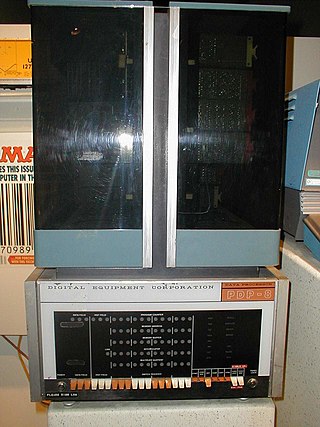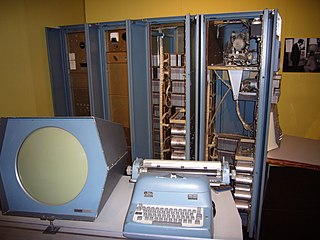
A minicomputer, or colloquially mini, is a class of smaller general purpose computers that developed in the mid-1960s and sold at a much lower price than mainframe and mid-size computers from IBM and its direct competitors. In a 1970 survey, The New York Times suggested a consensus definition of a minicomputer as a machine costing less than US$25,000, with an input-output device such as a teleprinter and at least four thousand words of memory, that is capable of running programs in a higher level language, such as Fortran or BASIC.

Programmed Data Processor (PDP), referred to by some customers, media and authors as "Programmable Data Processor," is a term used by the Digital Equipment Corporation from 1957 to 1990 for several lines of minicomputers.

The PDP-11 is a series of 16-bit minicomputers sold by Digital Equipment Corporation (DEC) from 1970 into the 1990s, one of a set of products in the Programmed Data Processor (PDP) series. In total, around 600,000 PDP-11s of all models were sold, making it one of DEC's most successful product lines. The PDP-11 is considered by some experts to be the most popular minicomputer.

A microcomputer is a small, relatively inexpensive computer having a central processing unit (CPU) made out of a microprocessor. The computer also includes memory and input/output (I/O) circuitry together mounted on a printed circuit board (PCB). Microcomputers became popular in the 1970s and 1980s with the advent of increasingly powerful microprocessors. The predecessors to these computers, mainframes and minicomputers, were comparatively much larger and more expensive. Many microcomputers are also personal computers. An early use of the term personal computer in 1962 predates microprocessor-based designs. (See "Personal Computer: Computers at Companies" reference below). A microcomputer used as an embedded control system may have no human-readable input and output devices. "Personal computer" may be used generically or may denote an IBM PC compatible machine.
The 801 was an experimental central processing unit (CPU) design developed by IBM during the 1970s. It is considered to be the first modern RISC design, relying on processor registers for all computations and eliminating the many variant addressing modes found in CISC designs. Originally developed as the processor for a telephone switch, it was later used as the basis for a minicomputer and a number of products for their mainframe line. The initial design was a 24-bit processor; that was soon replaced by 32-bit implementations of the same concepts and the original 24-bit 801 was used only into the early 1980s.

NCR Corporation, previously known as National Cash Register, is an American software, consulting and technology company providing several professional services and electronic products. It manufactures self-service kiosks, point-of-sale terminals, automated teller machines, check processing systems, and barcode scanners.

Data General Corporation was one of the first minicomputer firms of the late 1960s. Three of the four founders were former employees of Digital Equipment Corporation (DEC).

The history of computing hardware starting at 1960 is marked by the conversion from vacuum tube to solid-state devices such as transistors and then integrated circuit (IC) chips. Around 1953 to 1959, discrete transistors started being considered sufficiently reliable and economical that they made further vacuum tube computers uncompetitive. Metal–oxide–semiconductor (MOS) large-scale integration (LSI) technology subsequently led to the development of semiconductor memory in the mid-to-late 1960s and then the microprocessor in the early 1970s. This led to primary computer memory moving away from magnetic-core memory devices to solid-state static and dynamic semiconductor memory, which greatly reduced the cost, size, and power consumption of computers. These advances led to the miniaturized personal computer (PC) in the 1970s, starting with home computers and desktop computers, followed by laptops and then mobile computers over the next several decades.
AT&T Computer Systems is the generic name for American Telephone & Telegraph's unsuccessful attempt to compete in the computer business. In return for divesting the local Bell Operating Companies, AT&T was allowed to have an unregulated division to sell computer hardware and software. The company made the 3B series computers.
The BUNCH was the nickname for the group of mainframe computer competitors of IBM in the 1970s. The name is derived from the names of the five companies: Burroughs, UNIVAC, NCR, Control Data Corporation (CDC), and Honeywell. These companies were grouped together because the market share of IBM was much higher than all of its competitors put together.
Max Palevsky was an American art collector, venture capitalist, philanthropist, and computer technology pioneer. He was known as a member of the Malibu Mafia – a group of wealthy American Jewish men who donated money to liberal and progressive causes and politicians.

Simson L. Garfinkel is a Program Scientist at AI2050, part of Schmidt Futures. He has held several roles across government, including a Senior Data Scientist at the Department of Homeland Security (DHS), the US Census Bureau's Senior Computer Scientist for Confidentiality and Data Access. and a computer scientist at the National Institute of Standards and Technology (2015-2017). Prior to that, he was an associate professor at the Naval Postgraduate School in Monterey, California (2006-2015). In addition to his research, Garfinkel is a journalist, an entrepreneur, and an inventor; his work is generally concerned with computer security, privacy, and information technology.

A computer is a machine that can be programmed to carry out sequences of arithmetic or logical operations (computation) automatically. Modern digital electronic computers can perform generic sets of operations known as programs. These programs enable computers to perform a wide range of tasks. A computer system is a nominally complete computer that includes the hardware, operating system, and peripheral equipment needed and used for full operation. This term may also refer to a group of computers that are linked and function together, such as a computer network or computer cluster.

Midrange computers, or midrange systems, were a class of computer systems that fell in between mainframe computers and microcomputers.

The MADDIDA was a special-purpose digital computer used for solving systems of ordinary differential equations. It was the first computer to represent bits using voltage levels and whose entire logic was specified in Boolean algebra. Invented by Floyd Steele, MADDIDA was developed at Northrop Aircraft Corporation between 1946 and 1949 to be used as a guidance system for the Snark missile. No guidance system, however, resulted from the work on the MADDIDA, and rather it was used for aeronautical research. In 1952, the MADDIDA became the world's top-selling commercial digital computer, six units having been sold.
The history of video games spans a period of time between the invention of the first electronic games and today, covering many inventions and developments. Video gaming reached mainstream popularity in the 1970s and 1980s, when arcade video games, gaming consoles and home computer games were introduced to the general public. Since then, video gaming has become a popular form of entertainment and a part of modern culture in most parts of the world. The early history of video games, therefore, covers the period of time between the first interactive electronic game with an electronic display in 1947, the first true video games in the early 1950s, and the rise of early arcade video games in the 1970s. During this time there was a wide range of devices and inventions corresponding with large advances in computing technology, and the actual first video game is dependent on the definition of "video game" used.

The biographical book, The ultimate entrepreneur: the story of Ken Olsen and Digital Equipment Corporation, chronicles the experiences of Ken Olsen racing to design minicomputers at the company of his own founding, Digital Equipment Corporation. At the time the book was published by two computer journal writers, Ken Olsen was competing with other Massachusetts computing companies such as Data General, Prime Computer, Wang Laboratories, Symbolics, Lotus Development Corporation, and Apollo Computer. While believing in the value of software, he did not believe in the value of software separate from hardware, and missed the opportunity to fund Lotus 1-2-3 or Visicalc. He also missed the importance of the personal computer, but his futuristic vision of the Client–server model helped to launch Ethernet.
Simulation for Automatic Machinery or SAM were two unique minicomputers built by the Norwegian Defence Research Establishment (NDRE) in the mid-1960s. SAM 1, built between 1962 and 1964, was the first Norwegian-built programmable computer. It featured 4,096 14-bit words of memory and 14 registers and was used in-house at NDRE. SAM 2 was built between 1966 and 1967 and was used for analysis of satellite imagery at Tromsø Satellite Station. A third-generation computer, it was among the first three in the world to use integrated circuits.

Floyd George Steele was an American physicist, engineer, and computer designer who grew up in Boulder, Colorado. He is known for leading the design team at Northrup that developed the MADIDDA, an early digital computer.
Mainframe computers are computers used primarily by businesses and academic institutions for large-scale processes. Before personal computers, first termed microcomputers, became widely available to the general public in the 1970s, the computing industry was composed of mainframe computers and the relatively smaller and cheaper minicomputer variant. During the mid to late 1960s, many early video games were programmed on these computers. Developed prior to the rise of the commercial video game industry in the early 1970s, these early mainframe games were generally written by students or employees at large corporations in a machine or assembly language that could only be understood by the specific machine or computer type they were developed on. While many of these games were lost as older computers were discontinued, some of them were ported to high-level computer languages like BASIC, had expanded versions later released for personal computers, or were recreated for bulletin board systems years later, thus influencing future games and developers.












